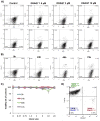Real-time cell viability assays using a new anthracycline derivative DRAQ7®
- PMID: 23165976
- PMCID: PMC3558543
- DOI: 10.1002/cyto.a.22228
Real-time cell viability assays using a new anthracycline derivative DRAQ7®
Abstract
The exclusion of charged fluorescent dyes by intact cells has become a well-established assay for determining viability of cells. In search for a noninvasive fluorescent probe capable of long-term monitoring of cell death in real-time, we evaluated a new anthracycline derivative DRAQ7. The novel probe does not penetrate the plasma membrane of living cells but when the membrane integrity is compromised, it enters and binds readily to nuclear DNA to report cell death. It proved to be nontoxic to a panel of cancer cell lines grown continuously for up to 72 h and did not induce any detectable DNA damage signaling when analyzed using laser scanning microscopy and flow cytometry. The DRAQ7 provided a sensitive, real-time readout of cell death induced by a variety of stressors such as hypoxia, starvation, and drug-induced cytotoxicity. The overall responses to anticancer agents and resulting pharmacological dose-response profiles were not affected by the growth of tumor cells in the presence DRAQ7. Moreover, we for the first time introduced a near real-time microflow cytometric assay based on combination of DRAQ7 and mitochondrial inner membrane potential (ΔΨ(m) ) sensitive probe TMRM. We provide evidence that this low-dosage, real-time labeling procedure provides multiparameter and kinetic fingerprint of anticancer drug action.
Copyright © 2012 International Society for Advancement of Cytometry.
Figures




Similar articles
-
Kinetic viability assays using DRAQ7 probe.Curr Protoc Cytom. 2013 Jul;Chapter 9:9.41.1-9.41.8. doi: 10.1002/0471142956.cy0941s65. Curr Protoc Cytom. 2013. PMID: 23835805 Free PMC article.
-
Quantification methods for human and large animal leukocytes using DNA dyes by flow cytometry.Cytometry A. 2016 Jun;89(6):565-74. doi: 10.1002/cyto.a.22874. Epub 2016 Jun 6. Cytometry A. 2016. PMID: 27271958
-
DRAQ7 as an Alternative to MTT Assay for Measuring Viability of Glioma Cells Treated With Polyphenols.Anticancer Res. 2020 Oct;40(10):5427-5436. doi: 10.21873/anticanres.14553. Anticancer Res. 2020. PMID: 32988864 Free PMC article.
-
Multiparameter analysis of apoptosis using lab-on-a-chip flow cytometry.Curr Protoc Cytom. 2013 Oct 9;66:9.42.1-9.42.15. doi: 10.1002/0471142956.cy0942s66. Curr Protoc Cytom. 2013. PMID: 24510726
-
Combination of ABT-737 and resveratrol enhances DNA damage and apoptosis in human T-cell acute lymphoblastic leukemia MOLT-4 cells.Toxicol In Vitro. 2017 Aug;42:38-46. doi: 10.1016/j.tiv.2017.03.013. Epub 2017 Mar 30. Toxicol In Vitro. 2017. PMID: 28366708
Cited by
-
Comprehensive Flow-Cytometric Quality Assessment of Ram Sperm Intended for Gene Banking Using Standard and Novel Fertility Biomarkers.Int J Mol Sci. 2022 May 25;23(11):5920. doi: 10.3390/ijms23115920. Int J Mol Sci. 2022. PMID: 35682598 Free PMC article.
-
Phenotypic Screening for Small Molecules that Protect β-Cells from Glucolipotoxicity.ACS Chem Biol. 2022 May 20;17(5):1131-1142. doi: 10.1021/acschembio.2c00052. Epub 2022 Apr 19. ACS Chem Biol. 2022. PMID: 35439415 Free PMC article.
-
Evaluation of impermeant, DNA-binding dye fluorescence as a real-time readout of eukaryotic cell toxicity in a high throughput screening format.Assay Drug Dev Technol. 2014 May;12(4):219-28. doi: 10.1089/adt.2014.577. Assay Drug Dev Technol. 2014. PMID: 24831788 Free PMC article.
-
Targeting protein homeostasis with nelfinavir/salinomycin dual therapy effectively induces death of mTORC1 hyperactive cells.Oncotarget. 2017 Jul 25;8(30):48711-48724. doi: 10.18632/oncotarget.16232. Oncotarget. 2017. PMID: 28415776 Free PMC article.
-
More than just life and death: advances in imaging and analysis for 3D-bioprinted tissues.Front Bioeng Biotechnol. 2025 Jun 11;13:1600077. doi: 10.3389/fbioe.2025.1600077. eCollection 2025. Front Bioeng Biotechnol. 2025. PMID: 40567257 Free PMC article.
References
-
- Wlodkowic D, Skommer J, Pelkonen J. Multiparametric analysis of HA14-1-induced apoptosis in follicular lymphoma cells. Leuk Res. 2006;30:1187–92. - PubMed
-
- Wlodkowic D, Skommer J, Pelkonen J. Brefeldin A triggers apoptosis associated with mitochondrial breach and enhances HA14-1- and anti-Fas-mediated cell killing in follicular lymphoma cells. Leuk Res. 2007;31:1687–700. - PubMed
-
- Darzynkiewicz Z, Juan G, Li X, Gorczyca W, Murakami T, Traganos F. Cytometry in cell necrobiology: analysis of apoptosis and accidental cell death (necrosis) Cytometry. 1997;27:1–20. - PubMed
-
- Khoshmanesh K, Akagi J, Nahavandi S, Skommer J, Baratchi S, Cooper JM, Kalantar-Zadeh K, Williams DE, Wlodkowic D. Dynamic analysis of drug-induced cytotoxicity using chip-based dielectrophoretic cell immobilization technology. Anal Chem. 2011;83:2133–44. - PubMed
Publication types
MeSH terms
Substances
Grants and funding
LinkOut - more resources
Full Text Sources
Other Literature Sources

